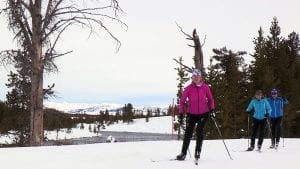
If you want to see Yellowstone in winter, and I highly recommend that you do, today you can either take a snowmobile, a snowcoach, a bombardier or you can cross country ski. While Yellowstone is an amazing place to visit any time of the year, to me at least, it is at its most magnificent in the wintertime.
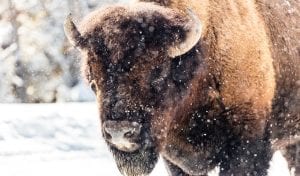
Bison warming up in Yellowstone National Park. Courtesy of Yellowstone National Park.
You will see acres and acres and acres of pristine snow where no human footprint can be found. The bison, elk, wolves, coyotes and bobcats are generally the only ones leaving their footprints in the otherwise undisturbed snow.
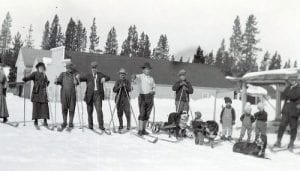
Courtesy of the Museum of the Yellowstone
For decades, the only method of travel in Yellowstone was on skis. In April of 1903, President Theodore Roosevelt took a special excursion by horse-drawn sleigh to Old Faithful and Canyon.
It would be only a matter of time before motorized travel in Yellowstone in the winter would become available.
There were quite a variety of vehicles used to travel the park in winter. The first motorized winter vehicle was something called a “screw tractor”. This was quite an odd-looking machine which consisted of a tractor mounted on two cylindrical tubes with raised spirals. The spirals pulled the machine across the snow while seemingly “floating” over drifts. It went between Roosevelt Lodge and Cooke City, Montana in the mid 1920’s.
Another quite odd-looking machine which was used by park workers during the winter was called “the weasel”. This particular vehicle was a leftover from World War II. It was a vehicle with tracks that the military had designed for snow warfare. It was similar to a small open-air tank but without a gun. It is reported that in May 1963 a B-47 bomber crashed near Shoshone Lake and the lone survivor was rescued by using “the weasel.”
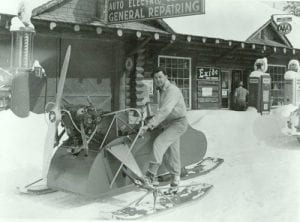
Courtesy of the Museum of Yellowstone
Walt Stuart, a West Yellowstone mechanic, came up with the idea of taking the wings off an airplane and mounting it on skis and thus the snow plane was born. These had been used elsewhere as a means of travel over-the-snow but they were first used in the park in 1949 Stuart’s three snow planes made a total of 19 trips into Yellowstone and carried a total of 35 people. The propeller, which was unguarded, was close to ground height and they were prone to tip over when then made sharp turns. When the snowcoaches arrived on the scene in 1955 the snow planes basically became a thing of the past.
In 1922 Carl J. E. Eliason, from Sayner, Wisconsin, began work on what he referred to as a “motor toboggan”. This consisted of a wooden toboggan fitted with two skis steered by ropes and pushed along by a steel-cleated track which was powered by a 2.5 horse-power outboard motor. He patented his machine and it was manufactured until 1960 by his company and then later by the FWD corporation in Canada. His 1927 patent stands, and his design was the first snow vehicle to be mass produced and reliable for the rider. His design has been widely copied.
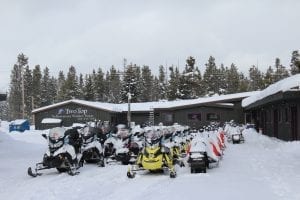
In 1963 the first snowmobiles arrived on the scene in Yellowstone. By 1970 the main mode of winter travel into Yellowstone was the snowmobile. The term “snowmobile” came into use in the mid-1920s when an American inventor engineered tracks and skis that would fit onto a Ford Model T and Model A cars. These vehicles would get you where you needed to go but they were quite heavy and slow.
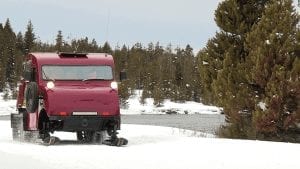
Bombardier Snowcoach into Yellowstone National Park. Courtesy of Dobson Entertainment.
The bombardier was one of the first commercially viable methods of transportation for over the snow travel. It was invented by Armand Bombardier, who was a Quebecois mechanical engineer. A 15-year-old Joseph-Armand Bombardier began work developing a car based snowmobile design. He wanted to create vehicles that would allow you to easily move in the show. He lived in Valcourt, Quebec, where the winters were quite hard and roads were not cleared for travel. His desire to complete his creation was spurred when in 1934 his son died after his appendix burst and the family were not able to get him to the hospital.
By 1935 he had created a track system that turned with sprockets (toothed wheels) which connected to and rotated the track. This invention resulted in the creation of the seven passenger B7 auto-neige in 1936. This vehicle had a lightweight cabin, a new rear suspension system and improved weight distribution. It found customers in postmen, clergy, army office and traveling doctors.
But he also continued to refine his snowmobile models. He wanted to create a smaller recreational snowmobile. The advancement in engine design allowed for a small engine which was powerful enough to drive a single or two-passenger vehicle which he named the Ski-Doo.
If you come to West Yellowstone in the winter you will find that you can rent everything you need to snowmobile from the machine to the clothing to a qualified guide. Yellowstone National Park is a magnificent place to see in winter but do not forget about the hundreds of miles of groomed snowmobile trails in the National Forest which is adjacent to our town. You will not want to miss the opportunity to take a guided snowmobile trip to see the “snow ghosts” of Two Top outside of town.
For more information on the history of winter travel in Yellowstone please visit Yellowstone Forever. Additional information is available at Smithsonian Magazine, The Museum of the Yellowstone, Bombardier, Inc and Eliason Snowmobiles.
AUTHOR: SUSIE KNAPP